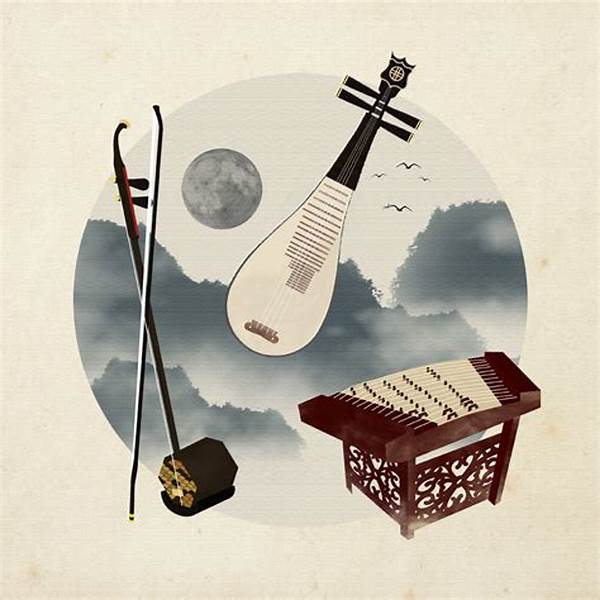Welcome to the fascinating world of Chinese traditional music instruments, where each note tells a story passed down through generations. Imagine being swept away by the poignant sounds of a guzheng or the haunting melody of an erhu. These instruments are more than just tools for making music; they are cultural relics that symbolize the grandeur of China’s dynastic culture. But why are these instruments so compelling? What makes them the heartbeat of dynastic traditions? Pull up a chair, grab a cup of tea, and let us take you on an enchanting journey that will leave you wanting to explore the rich tapestry of Chinese music and culture in depth.
Read More : Recommendations For Digital Sampler Instruments For Edm Producers In 2025
You might be asking yourself why you should care about ancient instruments when the world is abuzz with digital music and modern beats. Here’s why: understanding Chinese traditional music instruments isn’t just about exploring music history; it’s about connecting with a culture that profoundly values artistry, harmony, and balance. By diving into this subject, you’re not only enriching your knowledge but also gaining insights into a civilization that has shaped global cultures for millennia. So, let’s delve into the rhythmic pulse of China’s dynastic eras and discover how these traditional instruments serve as lasting symbols of cultural expression.
The Legacy of Chinese Traditional Instruments
China’s traditional music instruments have etched their existence into the tapestry of history, with each string and reed weaving tales from ancient dynasties. The qin, a seven-stringed zither, was cherished by the literati of the Zhou dynasty, revered for its melodic abilities to convey Confucian ethics and Taoist philosophy. The erhu, with its origins in the Tang dynasty, evokes emotions deeply, striking cords of both melancholic and joyful remembrance.
These instruments stand as enduring metaphors for China’s dynastic culture. They encapsulate not just music but a legacy, a way of life that mirrors the sophistication of China’s historical empires. Picture a court musician in imperial robes, playing the guzheng for an attentive audience, each note resonating with the grace and splendor of a dynasty. Each instrument tells its own unique story, bridging the annals of time with today’s modern world.
Musical Instruments as Cultural Pillars
But what makes these instruments so iconic? It’s the combination of craftsmanship, symbolic meaning, and emotive power. The pipa, a pear-shaped lute, has been a favorite since the Han dynasty, with its name reflecting the playing techniques: “pi,” meaning to play forward, and “pa,” backward. This duality symbolizes the balance that Chinese culture strives to achieve—a harmony between past and future, yin and yang.
Chinese traditional music instrument symbols of dynastic culture are more than melodies; they are a code to understanding a civilization’s ethos. Each instrument resonates uniquely, not just musically but culturally, uniting people under an umbrella of shared history and identity. This isn’t merely playing music; it is breathing life into historical narratives long forgotten.
The Emotional and Symbolic Roles of Instruments
Chinese traditional music instruments do more than entertain; they educate and evoke a spectrum of emotions. The guzheng’s strings sing poetry, the dizi (bamboo flute) narrates folklore, and the sheng (mouth organ) celebrates communal joy. Each instrument taps into different emotional reservoirs, allowing performers and audiences alike to explore intricate narratives.
A Bridge to Dynastic Identity
These instruments provide an emotional and cultural bridge to China’s dynastic identity. Consider the deep, resonating sound of the xiao, a vertical end-blown flute. Often performed in scholarly circles during the Song dynasty, it elevated the aesthetic appreciation of music. It wasn’t just sound; it was an experience shared by the community, a means of collective introspection, and identity affirmation.
These instruments are emblematic, representing the nuances of life as understood by different dynasties. They provide a canvas on which history paints its epic narratives, a feature that makes them invaluable in the modern world as a link to the past.
Read More : Traditional Balinese Gamelan Instruments Combined With Edm
Points on Chinese Traditional Music Instruments
Understanding the points below can offer a deeper appreciation for the craft and significance of these instruments:
Modern Applications of Ancient Sounds
In today’s globalized world, these instruments are not relics of a bygone era but dynamic components of modern musical dialogues. Chinese traditional music instruments continue to inspire, finding their way into fusion genres and collaborations worldwide, bridging cultural gaps and bringing a piece of dynastic China to a global audience.
Summary: The Timeless Appeal of Chinese Instruments
To summarize, Chinese traditional music instrument symbols of dynastic culture are treasures that encapsulate the soul of a civilization. They tell stories of valor and virtue, echoing the philosophical underpinnings of a way of life that continues to fascinate and inspire. As the world speeds towards the future, these instruments anchor us to the past, teaching us lessons in empathy, balance, and beauty.
Chinese traditional music instrument symbols of dynastic culture serve as vital reminders of the enduring power of music to convey cultural narratives. Through their ancient chords, we find a symphony of human experience, a narrative arc that leads us from China’s dynastic opulence to today’s global arenas.
In a world hungry for connection, these instruments offer a way to bridge cultures and time periods. Their music speaks a language that doesn’t need translation, resonating universally regardless of one’s background or beliefs. As you continue your journey into this melodious world, remember: every note played is a note from history, waiting for you to listen, learn, and appreciate.
